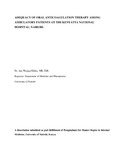Adequacy of oral anticoagulation therapy among ambulatory patients at Kenyatta National Hospital, Nairobi
Abstract
Thrombosis is a major public health problem that is associated with significant morbidity and mortality. Warfarin is an important drug used both in the primary and secondary prophylaxis of thromboembolism. Monitoring of patients on warfarin therapy is essential to ensure that they are adequately anticoagulated as over-anticoagulation may cause hemorrhage while under- anticoagulation may lead to thromboembolic complications. It is therefore important that centers that run anticoagulation clinics periodically assess the adequacy of anticoagulation on their patients.
Objective: To determine the adequacy of anticoagulation in patients on warfarin therapy and associated factors in Kenyatta National Hospital (KNH).
Study design: A Cross- sectional descriptive study.
Study setting: - KNH, (a tertiary, referral and teaching hospital) outpatient clinics.
Study participants: -Adult patients on warfarin therapy for a minimum duration of two weeks followed up :n the cardiac, hemato-oncology and cardiothoracic clinics.
Sample size: The minimum number of patients in this study was 99 patients.
Sampling .technique: Consecutive sampling was done till the desirable sample size was achieved.
Method: Consenting eligible patients on warfarin therapy were recruited into the study on their follow up visit to KNH, interviewed using a structured questionnaire (Appendix 1) regarding their socio- demographic characteristics, duration of warfarin therapy and clinic attendance intervals. Thromboembolic or hemorrhagic complications while on warfarin were documented.
The presence of factors that could interfere with the stability of INR such as non-adherence, variable intake of foods rich in vitamin K, concurrent use of drugs that interact with warfarin and alcohol intake was documented. Other relevant clinical information was retrieved from the patient's medical records.
Two mls of blood were drawn aseptically put in a vacutainer containing sodium citrate and delivered in a cool box to the University of Nairobi hematology laboratory for analysis of PTIIINR (Appendix 2). INR analysis was carried out within 3 hours. The level of anticoagulation was determined by the time- intherapeutic range using the Roosendaallinear interpolation method (Appendix 3).
The data collected was verified, entered into a Microsoft Access database, cleaned and analysis done using S PSS version 17.0. Data Presentation was done p,i ng frequency taples, graphs and pie charts. Factors that interfere with control of INR were detemlined by comparing the patients with TfR <60% and those with TfR 60% in terms of adherence, concurrent medicat'on use, variability in dietary and alcohol intake. Comparisons were done using the Chi .square test. P values of $0.05 were considered significant while 95% confidence limits was used be used to measure certainty.
Results: One hundred and twelve patients were screened between 3'' September 2011 and January 16TIl 2012. Twelve patients were excluded for various reasons. Two were pregnant. six were on warfarin for less than 2 weeks and four had missing files. The rest 100 patients were recruited into the study. The study participants were young with a mean age of 41.4 years and most were females 81(81%). The large majority of patients on warfarin had venOUS thromboembolism 66(66%), 21(21%) had prosthetic valves and \3(\3%) had other cardiac problems like atrial fibrillation. Eighty five(85% )of the study population had low TfRs less than 60% as determined by the Rosendaal method denoting low levels of anticoagulation.
Even when cross section of INRs was used, 69(69%) of the study population had their INRs out of therapeutic range. poor adherence to warfarin was noted in 39(39%) of the study population, while use of a concurtent interacting medicine was noted in 21 (21 %) of the study population. The use of variable amounts of vegetables was noted in 31(60%) of the study population. Howev.' there was no association between these factors and the time spent in therapeutic range.
Conclusion: The vast majority of patients on warfarin therapy in this study spent most of their time with their INRs being out of therapeutic range.
Publisher
University of Nairobi, Kenya

